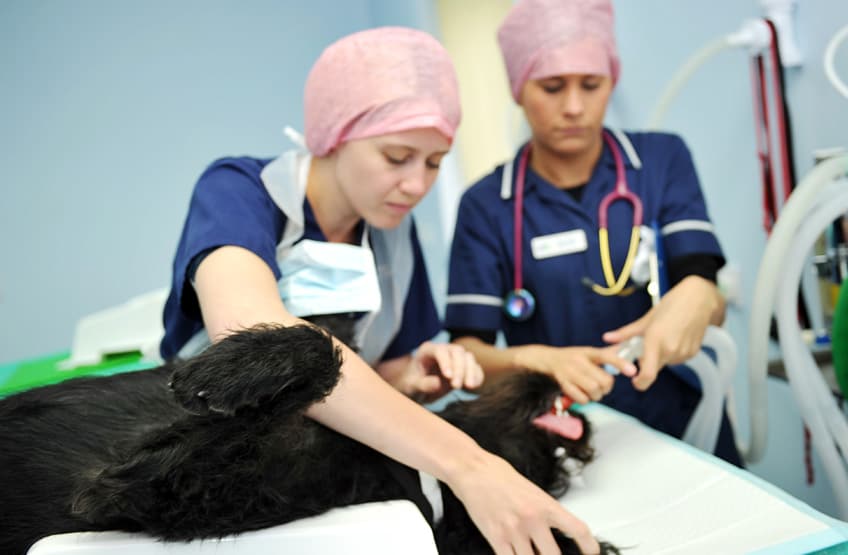Below is a list of common queries our clients have when their cat or dog stays in the hospital with us for an operation.
What happens when my cat/dog is admitted for an operation?
On the morning of the procedure you will have an admission appointment with either one of our vets or nurses where they will discuss the procedure and complete your consent form. This appointment usually takes about 15 minutes so please allow plenty of time. The consent form will detail the operation to be performed, provide you with an estimate of costs and an opportunity to discuss any concerns that you may have. It is essential that we are able to contact you at all times whilst your pet is in with us.
This is so we can keep you updated on your pets progress but also in case of any emergencies. Please make sure we have your correct phone number and that you will be available on that number during your pets stay with us. Should your pet be on any medication, please discuss with your vet whether the medication should be continued as usual around the time of the operation. On admission, please inform us when the medication was last given and of any changes to your pet’s health since they were last seen by a vet. Please ensure that your pet is clean and dry, especially if they are coming in for an operation as this will take place in a clean theatre.
Why has a pre-anaesthetic blood test been recommended?
A pre-anaesthetic blood screen is recommended to assess your pet’s general health and suitability to undergo general anaesthesia. The blood test results will allow the vet to assess whether any adjustments need to be made to your pets anaesthetic protocol, such as the use of supportive intravenous fluid therapy.
The pre-anaesthetic blood screen also provides an excellent opportunity to assess your pet's general health and pick up on any diseases that may be in the early stages and therefore affecting your pet without any visible external signs. Identification of any disease at an early stage allows any necessary investigations to be performed and measures put in place help to rectify or manage the condition. This is particularly relevant to our more senior patients.
What’s involved when giving my cat/dog a general anaesthetic?
The anaesthetic drugs that are used will be chosen according to each animal’s individual requirements as determined by the type of operation that is being performed and the medical history and findings from a physical examination of your pet. Animals undergoing a general anaesthetic are usually given a pre-medication before their anaesthetic. This is a combination of a pain relief and a sedative. The 'pre-med' will help to make your pet feel more relaxed and sleepy and it helps to reduce the amount of anaesthetic agent we need to use, allowing for a smoother induction and recovery.
When we are ready to start the operation, the induction drug is given. This is usually injected into the vein on the front of the leg, after clipping away a small amount of fur. Your pet will become unconscious in just a few seconds. A tube is placed into the trachea (windpipe) and connected to a gas anaesthetic machine, supplying measured amounts of oxygen, isoflurane and or nitrous oxide (the anaesthetic gases) directly to your pet. Your pet will be closely monitored by a nurse dedicated solely to your pet throughout their entire anaesthetic and recovery. Although modern sedative and anaesthetic agents are very safe, all anaesthetics do carry an element of risk.
This is usually minimal, but any concerns should be discussed with your vet.
How much fur will you clip off my cat/dog?
How much we clip your pet will depend on the procedure they are coming in for. Clipping is essential so that injection and surgical sites are kept sterile, which minimise the risk of infection and aids wound healing.
- Blood samples: a patch of fur clipped over the neck or leg
- Operations (including neutering): a larger area of fur is clipped at the site of the operation
- Ultrasound: a large area of fur over their belly and sides is clipped to ensure good contact between the skin and the probe, ensuring the ultrasound image is of good diagnostic quality.
If you have any concerns about your pet being clipped, please discuss this with your vet/nurse.
When can I collect my cat/dog after surgery?
For routine operations, discharge appointments typically take place after 3pm on the same day. The vet will call you with an update once your pet is in recovery from their anaesthesia. A discharge appointment will then be made or a pre-booked appointment confirmed. Occasionally animals may require hospitalisation overnight for further observation.



Our Services